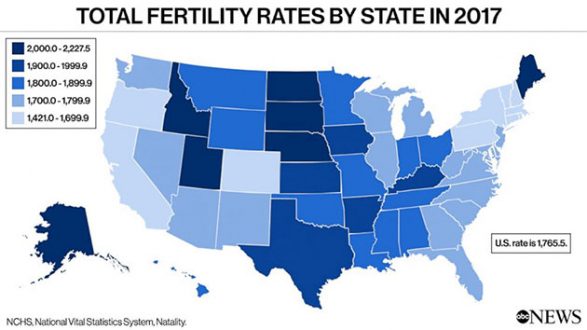
 ABC News(NEW YORK) — When sociology professor Caitlyn Collins set out to interview 135 middle-class women in Sweden, Germany, Italy and the U.S. about how they make motherhood work with their careers, she was surprised by what set American women apart.
ABC News(NEW YORK) — When sociology professor Caitlyn Collins set out to interview 135 middle-class women in Sweden, Germany, Italy and the U.S. about how they make motherhood work with their careers, she was surprised by what set American women apart.
“Moms in the U.S. stand apart from these other women in how guilty and stressed and conflicted they are. Of course, moms everywhere feel work-family conflict, but what is unique about the American mom, and this is the most heartbreaking part of what I found in my study, is that American moms blame themselves for this work-family conflict,” Collins told ABC News. “They think if they try a little bit harder or read the right parenting book, or adopt the right scheduling approach to their family’s everyday lives, that things would be better and they would be able to keep their head above the tidewaters.”
“Women are blaming themselves as individuals for something that is a deeply structural and societal problem,” added Collins, who wrote about her findings in the forthcoming book “Making Motherhood Work: How Women Manage Careers and Caregiving.”
The financial and emotional obstacles mothers face were brought to the fore this week after a new report found that American women aren’t having enough babies to replace the current population, and the nation’s total fertility rate has hit a 30-year low. Total fertility rates represent the expected number of lifetime births per 1,000 women, given current birth rates by age.
But experts like Collins weren’t surprised. They say the lack of mandatory paid family leave, supportive workplace policies for mothers and the dearth of affordable childcare, housing and higher education have all contributed to the decline.
“There are real demographic consequences for not supporting families,” Collins said. “We are horrifyingly far behind. The U.S. is one of the most family-hostile countries across the world, which is really sad. We talk a lot about families sort of being the backbone of our society, but we don’t support that with any material policies that would actually enable people to reconcile their work and family lives.”
The nation’s total fertility rate was 16 percent below the level for a population to replace itself in 2017, a National Vital Statistics report published this week found. Only two states — South Dakota and Utah — had total fertility rates above replacement levels. The gap between South Dakota, which had the highest rate, and Washington, D.C., which had the lowest rate, was 57 percent.
Total fertility rates in the U.S. have been declining for years and women are generally giving birth for the first time later in life, according to the Centers for Disease Control and Prevention. Part of the age increase for first-time mothers is due to the decline in teenage pregnancies. But, in general, women are waiting longer to have children too.
Raising a child in the U.S. is expensive. In its recent “Cost of Raising a Child” report, the U.S. Department of Agriculture found that middle-income, married parents of a child born in 2015 could expect to spend $233,610 on food, housing, and other necessities to raise that child through age 17. The estimate did not take into account college tuition costs, and it rose to $284,570 when adjusted for projected inflation.
Economic uncertainty and student loan debt are two factors that impact women’s decisions about when to start families, according to Dr. Karen Guzzo, the associate director of the Center for Family & Demographic Research at Bowling Green State University. Guzzo said demographers expected to see fertility rates bounce back as the country recovered from the 2008 financial crisis, but that hasn’t happened.
“They really haven’t recovered as much as we had expected, and I think that suggests a lot about how people feel in terms of their own personal lives and how secure they feel. It’s not just the global or national economic or GDP numbers, it’s, ‘Can I pay my bills, can I pay my student loans, can I buy a house, is my job secure? Do I have a strong relationship and can I maintain that?’ So people go through a lot of uncertainty,” Guzzo told ABC News. “I really think that those characteristics haven’t improved as much over the last 10 years, and that’s probably what’s going on here.”
Lack of federally mandated, universal paid family leave is also a factor. Currently, companies, states and cities can decide their own policies, which leads to a disparity. Women can’t count on having paid maternity leave if they switch jobs, for example, said Kate Ryder, the CEO and founder of Maven, a digital clinic for women.
“Without federally mandated paid leave and with about 50 percent of babies born per year on corporate health plans, employers are the ones who are on the hook for the lack of government support and therefore in the driver’s seat on this fundamental health care issue in women’s health,” Ryder told ABC News via email. “They select coverage implications and leave policies and what types of support they’re giving, so two women who graduated from the same class in college but pursued two different career paths will have dramatically different maternity experiences based on the decisions of the HR/benefits teams of the employers they work for.”
The U.S. is an outlier in not offering mandatory paid family leave nationwide; nearly every other country in the world guarantees some kind of paid leave in weeks or months, according to the World Policy Analysis Center at UCLA.
Besides less than a handful of countries, “the rest of the industrialized world — and really, the rest of the world — understands that supporting families and having children be raised in healthy environments is for the benefit of all of us,” Collins said.
Childcare costs are another huge factor. Full-time childcare in a daycare center for a child between birth and 4 years old costs more, on average, than in-state college tuition, according to a 2016 Care Index report produced by New America, a bipartisan think tank. A family earning the average median income in the U.S. spends about one-fifth of their household income on childcare for one child, the report found; for women making minimum wage, full-time childcare costs 64 percent of their income.
“We don’t have something like high-quality, universal and affordable childcare, and the cost of outsourcing to the market in a liberal welfare state like ours is the equivalent or more than many women’s salaries,” Collins said. “What that means is they leave the workforce, and that has absolutely disastrous consequences for women over the course of their lives as it relates to their pensions, their lifetime earning potential, all sorts of factors. It hurts all women, but I think it hurts poor women especially.”
For families with one child considering having a second, that calculus can be even more difficult.
“People think, ‘Oh my gosh, I can’t afford to have a second kid. I’m strapped, I can’t even afford daycare as it is, so having another kid is just too much,'” Guzzo said. “I think the paid leave and childcare costs are important when people are having their first one, but I think it’s probably even more important in whether you go on to have that second or third kid. People are saying, ‘I don’t know, it was really tough to manage the first time around, or I didn’t get to spend enough time off with my kid, or I had to go back to work too early or my spouse didn’t get any time off and this is too much.'”
There is also a myth that women who leave their jobs after having children are choosing to “opt out” and be stay-at-home moms by choice. While that may be the case for some, many others leave careers they love because of a lack of support in the form of flexible schedules, paid time off and sick leave to care for children and the ability to work from home when needed.
“These highly educated, highly successful working mothers are being pushed out of unsupportive workplaces that haven’t adapted to the reality that all workers have external responsibilities — especially family responsibilities — that need to be accommodated if what we want is a replacement rate for fertility, and a robust economy that is internationally competitive,” Collins said. “Without these supports, we do see a brain drain.”
That lack of understanding about how hard it is to work and parent isn’t just something that women experience; companies are caught by surprise, too, Ryder said.
“Forty-three percent of new moms drop out of the workplace after having a baby when more than 75 percent have said they wanted to stay,” Ryder said. “Aside from the emotional and physical impact of motherhood, two other major contributing factors include an unsupportive work environment and insufficient preparation. It’s not just new mothers that need to prepare for the return-to-work transition, it’s managers too, and that preparation should begin as soon as a woman finds out she’s pregnant.”
According to a Maven Clinic white paper, letting mothers walk out the door is costly for companies as well, citing figures that state that replacing an employee after childbirth can cost between 20 percent to 213 percent of her salary.
“For a woman who returns to work and then ends up quitting within the first year, the cost to an employer can reach six figures, taking into account absenteeism, health care and turnover costs,” Ryder explained.
All three women agreed that changing policies at the workplace and federal level could make a huge difference.
Guzzo said policies that make college, housing and childcare more affordable could go a long way toward getting the U.S. fertility rate back to the replacement level.
“The U.S. can recover from this. A lot of people are delaying having kids, but they’re not saying never. In the long-term, this might not be this sort of huge crisis,” Guzzo said. “There are all these things we can do to reduce some of that financial insecurity and uncertainty young adults feel that would go a long way to helping our fertility rates.”
Collins agreed.
“It’s not rocket science. It’s whether we as a country have the political will to support families,” she said. “This is a political issue and it needs political solutions, not the assumption that women can solve these things as individuals on their own. And I think if women understood that — that their stress, their guilt, their conflict, is not their own fault it’s actually a political issue that the government needs to be involved in, we would take some of that guilt off mothers.”
Copyright © 2019, ABC Radio. All rights reserved.










